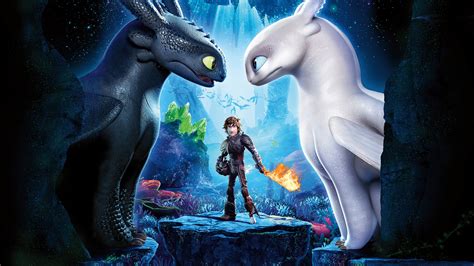How To Train Your Dragon: A Hidden World Is A Massive Success

Image belongs to Dreamworks
March 1, 2019
The How To Train Your Dragon movie franchise, the first of which came out in 2010, just released its highly anticipated final film in the trilogy: How to Train Your Dragon: The Hidden World. The movie was released on February 22nd, and already has 275 million gross revenue at the time of writing. The film itself was beyond what anyone could have expected. With a riveting plot and a new, well-written villain, the film delivered a story that not only children could enjoy, but adults as well.
The first film introduces the trilogy with main character Hiccup living with his father and clan chief Stoic in a Viking land called Berk that hates one thing: dragons. Dragon hunting is honored, and the un-domesticated dragons attack Viking villages viciously and often. This all changes, however, when Hiccup domesticates a fallen Nightfury, a nearly extinct species of dragon that is known to be one of the most dangerous kinds. After he is exposed to the clan, he stresses to his father that an alliance with domesticated dragons could benefit the people of Berk, and the rest is history. The second movie introduces a Berk that is more familiar with dragons, and that has adjusted to living with them in everyday life. More people are dragon riders now, and Hiccup continues to explore islands beyond his home. It’s in this way that he finds a monstrous hidden cove filled with dragons, and a dragon rider never before seen in the first film. This baffles him, and he later finds out that this rider is actually his long lost mother. From there, he persuades her to come back to Berk, where there is a great battle to end the second movie in the franchise.
With the third film, let’s start with the breathtaking animation. Though the first two movies certainly goes above and beyond in creating larger than life dragons and visually stunning landscapes, this third film absolutely blows away its audiences using scenes that have huge environments with vivid colors and intricate details. The dragons themselves are fantastically diverse and exotic. Dreamworks creators certainly thought out the lifestyle, architecture, and clothing of the time period as well, with accurate representations of Viking life. This includes armor designs, housing, and even small things such as plant life that added to the atmosphere of the film. Even tiny details that many audience members might fail to catch make an appearance, such as the brushstrokes of a paintbrush that Hiccup, the main character, uses to paint a prosthetic wing for his dragon, Toothless.
On a different plane of creativity, the plot keeps the audience glued to their seats, with twists and turns keeping their eyes glued to the screen. We also get more of a backstory into Hiccup’s childhood, with flashbacks to his younger years and his mother’s disappearance. This leads to another topic: character development. While the first two films focused mostly on story lines, this one created fantastic characters that progressed as the film went on, with Hiccup struggling as a new chief leading a clan of rowdy Vikings. He’s also pressured into being a leader without his dragon, and this pressures him into making decisions differently. Astrid, Hiccup’s girlfriend, also develops into more of an adult and tries to help her significant other as best she can. Even minor characters that we see from the last movie, such as Hiccup’s mother Valka, show new sides of their characters that help to further develop the plot and emotional investment of the audience.
Overall, Dreamworks did an outstanding job with this third film in the How To Train Your Dragon trilogy, and as an audience member I couldn’t have asked for more. This one had it all: serious moments, comic relief, stunning and beautiful animation, well-developed characters, and most importantly, tons of dragons, action and adventure.

